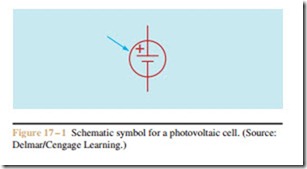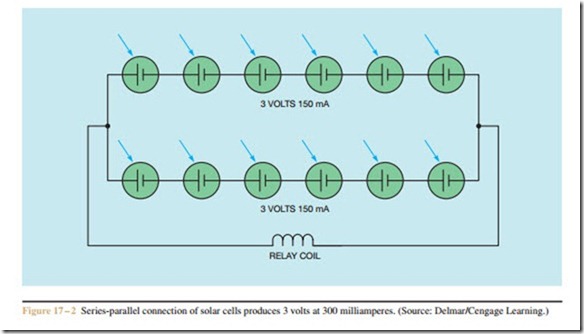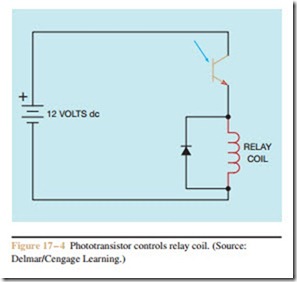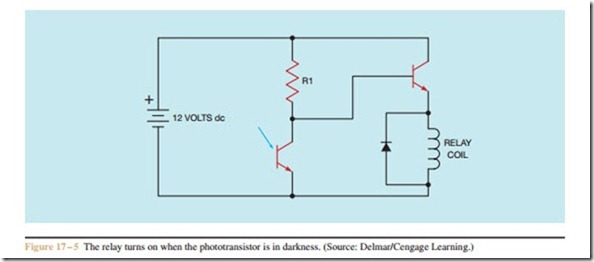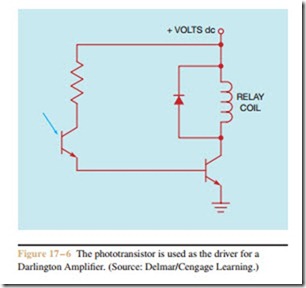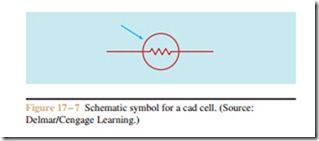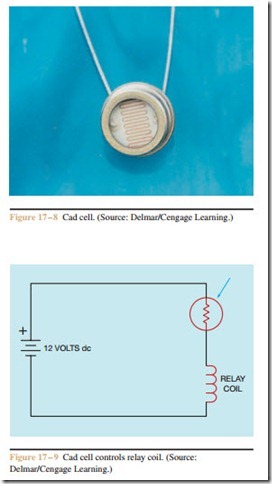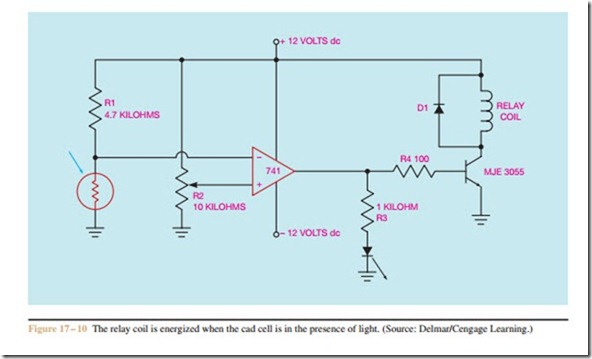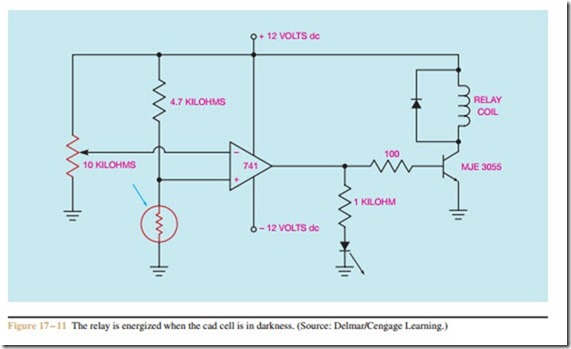Applications
Photo detectors are widely used in today’s industry. They can be used to sense the presence or absence of almost any object. Photo detectors do not have to make physical contact with the object they are sensing, so there is no mechanical arm to wear out. Many photo detectors can operate at speeds that cannot be tolerated by mechanical contact switches. They are used in almost every type of industry, and their uses are increasing steadily.
Types of Detectors
Photo-operated devices fall into one of three categories: photovoltaic, photoemissive, and photoconductive.
Photovoltaic
Photovoltaic devices are more often called solar cells. They are usually made of silicon and have the ability to produce a voltage in the presence of light. The amount of voltage produced by a cell is determined by the material it is made of. When silicon is used, the solar cell produces 0.5 volts in the presence of direct sunlight. If there is a complete circuit connected to the cell, current will flow through the circuit. The amount of current produced by a solar cell is determined by the surface area of the cell. For instance, assume a solar cell has a surface area of 1 square inch, and another cell has a surface area of 4 square inches. If both cells are made of silicon, both will produce 0.5 volts when in direct sunlight. The larger cell, however, will produce four times as much current as the small one.
the symbol used to represent a single cell battery except for the arrow pointing toward it. The battery symbol means the device has the ability to produce a voltage, and the arrow means that it must receive light to do so.
Photovoltaic cells have the advantage of being able to operate electrical equipment without external power. Since silicon solar cells produce only 0.5 volt, it is often necessary to connect several of them together to obtain enough voltage and current to operate the de- sired device. For example, assume that solar cells are to be used to operate a DC relay coil that requires 3 volts at 250 milliamperes. Now assume that the solar cells to be used have the ability to produce 0.5 volt at 150 milli- amperes. If six solar cells are connected in series, they will produce 3 volts at 150 milliamperes (Figure 17 – 2). The voltage produced by the connection is sufficient to
operate the relay, but the current capacity is not. There- fore, six more solar cells must be connected in series. This connection is then connected parallel to the first connection, producing a circuit that has a voltage rating of 3 volts and a current rating of 300 milliamperes, which is sufficient to operate the relay coil.
Photoemissive Devices
Photoemissive devices emit electrons when in the presence of light. They include such devices as the phototransistor, the photodiode, and the photo-SCR. The schematic symbols for these devices are shown in Figure 17 – 3. The emission of electrons is used to turn these solid-state components on. The circuit in Figure 17 – 4 shows a phototransistor used to turn on a
relay coil. When the phototransistor is in darkness, no electrons are emitted by the base junction, and the transistor is turned off. When the phototransistor is in the presence of light, it turns on and permits current to flow through the relay coil. The diode connected parallel to the relay coil is known as a kickback, or freewheeling, diode. Its function is to prevent induced voltage spikes from occurring if the current suddenly stops flowing through the coil and the magnetic field collapses.
In the circuit shown in Figure 17 – 4, the relay coil will turn on when the phototransistor is in the presence of light, and turn off when the phototransistor is in dark- ness. Some circuits may require the reverse operation.
This can be accomplished by adding a resistor and a junction transistor to the circuit (Figure 17 – 5). In this circuit, a common junction transistor is used to control the current flow through the relay coil. Resistor R1 limits the current flow through the base of the junction transistor. When the phototransistor is in darkness, it has a very high resistance. This permits current to flow to the base of the junction transistor and turn it on. When the phototransistor is in the presence of light, it turns on and connects the base of the junction transistor to the negative side of the battery. This causes the junc- tion transistor to turn off. The phototransistor in the cir- cuit is used as a stealer transistor. A stealer transistor steals the base current away from some other transistor to keep it turned off.
Some circuits may require the phototransistor to have a higher gain than it has under normal conditions. This can be accomplished by using the phototransis- tor as the driver for a Darlington amplifier circuit, Figure 17 – 6. A Darlington amplifier circuit generally has a gain of over 10,000.
Photodiodes and photo-SCRs are used in circuits similar to those shown for the phototransistor. The photodiode will permit current to flow through it in the presence of light. The photo-SCR has the same operating characteristics as a common junction SCR. The only difference is that light is used to trigger the gate when using a photo-SCR.
Regardless of the type of photoemissive device used or the type of circuit it is used in, the greatest advantage of the photoemissive device is speed. A photoemissive device can turn on or off in a few
microseconds. Photovoltaic or photoconductive de- vices generally require several milliseconds to turn on or off. This makes the use of photoemissive devices im- perative in high speed switching circuits.
Photoconductive Devices
Photoconductive devices exhibit a change of resis- tance due to the presence or absence of light. The most common photoconductive device is the cadmium sul- fide cell, or cad cell. A cad cell has a resistance of about 50 ohms in direct sunlight and several hundred thousand ohms in darkness. It is generally used as a light sensitive switch. The schematic symbol for a cad cell is shown in Figure 17 – 7. Figure 17 – 8 shows a typical cad cell.
Figure 17 – 9 shows a basic circuit of a cad cell be- ing used to control a relay. When the cad cell is in dark- ness, its resistance is high. This prevents the amount of current needed to turn the relay on from flowing through
the circuit. When the cad cell is in the presence of light, its resistance is low. The amount of current needed to operate the relay can now flow through the circuit.
Although this circuit will work if the cad cell is large enough to handle the current, it has a couple of problems:
1. There is no way to adjust the sensitivity of the circuit.
Photo-operated switches are generally located in many different areas of a plant. The surrounding light intensity can vary from one area to another. It is, therefore, necessary to be able to adjust the sensor for the amount of light needed to operate it.
2. The sense of operation of the circuit cannot be changed. The circuit shown in Figure 17 – 9 permits the relay to turn on when the cad cell is in the presence of light. There may be conditions that would make it desirable to turn the relay on when the cad cell is in darkness.
Figure 17 – 10 shows a photodetector circuit that uses a cad cell as the sensor and an operational amplifier (op amp) as the control circuit. The circuit operates as follows: Resistor R1 and the cad cell form a voltage divider circuit, which is connected to the inverting input of the amplifier. Resistor R2 is used as a potentiometer to preset a positive voltage at the nonin- verting input. This control adjusts the sensitivity of the circuit. Resistor R3 limits the current to a light-emitting diode (LED). The LED is mounted on the outside of the case of the photodetector and is used to indicate when the relay coil is energized. Resistor R4 limits the base current to the junction transistor. The junction transis- tor is used to control the current needed to operate the relay coil. Many op amps do not have enough current rating to control this amount of current. Diode D1 is used as a kickback diode.
Assume that Resistor R2 has been adjusted to pro- vide a potential of 6 volts at the noninverting input.
When the cad cell is in the presence of light, it has a low resistance, and a potential less than 6 volts is applied to the inverting input. Since the noninverting input has a higher positive voltage connected to it, the output is high also. When the output of the op amp is high, the LED and the transistor are turned on.
When the cad cell is in the presence of darkness, its resistance increases. When its resistance becomes greater than 4.7 kilohms, a voltage greater than 6 volts is applied to the inverting input. This causes the output of the op amp to change from a high state to a low state, and to turn the LED and transistor off. Notice in this circuit that the relay is turned on when the cad cell is in the pres- ence of light, and turned off when it is in darkness.
Figure 17 – 11 shows a connection that will reverse the operation of the circuit. The potentiometer has been reconnected to the inverting input, and the voltage divider circuit has been connected to the noninverting input. To understand the operation of this circuit, as- sume that a potential of 6 volts has been preset at the inverting input.
When the cad cell is in the presence of light, it has a low resistance, and a voltage less than 6 volts is applied to the noninverting input. Since the inverting input has a greater positive voltage connected to it, the output is low and the LED and the transistor are turned off.
When the cad cell is in darkness, its resistance be- comes greater than 4.7 kilohms, and a voltage greater than 6 volts is applied to the noninverting input. This causes the output of the op amp to change to a high state that turns on the LED and transistor. Notice that this circuit turns the relay on when the cad cell is in darkness and off when it is in the presence of light.
